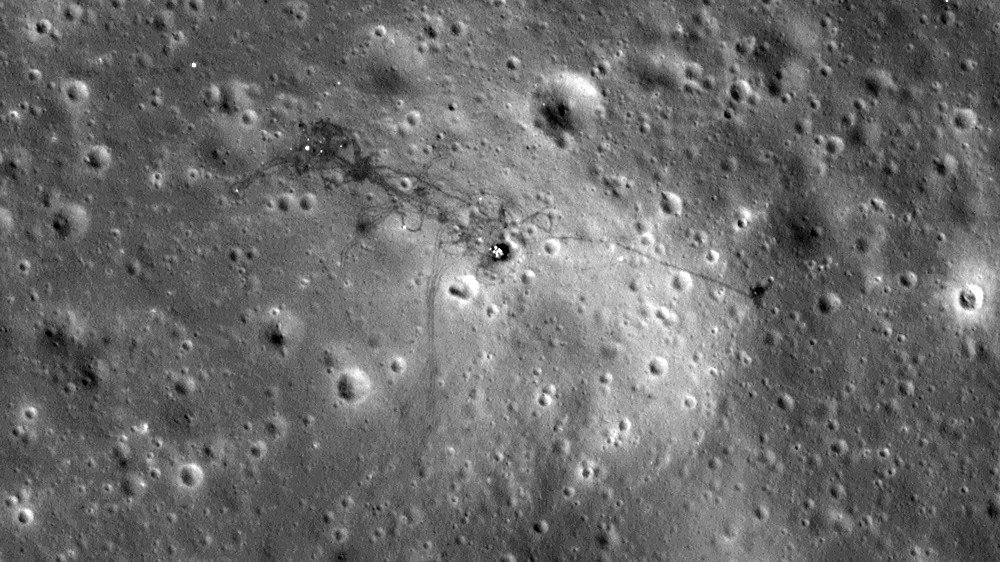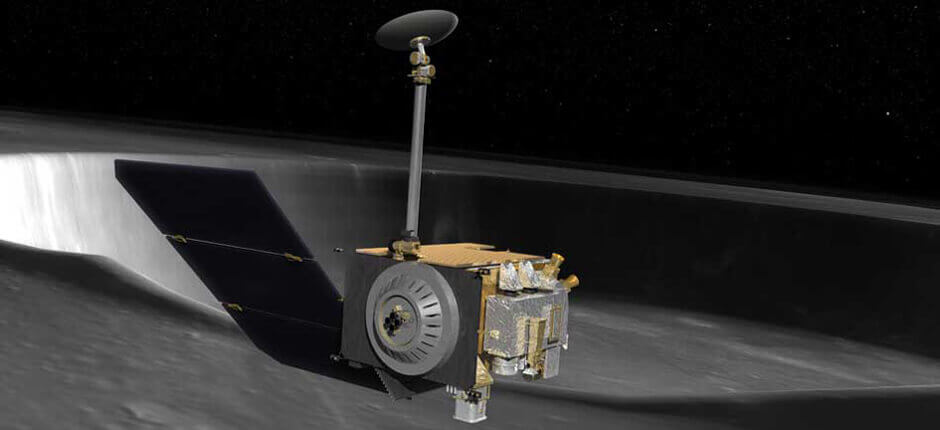In Depth: Lunar Reconnaissance Orbiter
The Lunar Reconnaissance Orbiter (LRO) was launched with the Lunar Crater Observation and Sensing Satellite (LCROSS) on the first U.S. mission to the Moon in over 10 years. Both were part of NASA’s now-canceled Lunar Precursor Robotic Program.
LRO’s primary goal was to make a 3D map of the Moon’s surface from lunar polar orbit as part of a high-resolution mapping program to identify landing sites and potential resources, to investigate the radiation environment, and to prove new technologies in anticipation of future automated and human missions to the surface of the Moon.
The Centaur upper stage boosted both LRO and LCROSS into high apogee orbits soon after launch. At 11:27 UT June 23, 2009, LRO successfully entered orbit around the Moon, having fired its rocket motor on the far side of the Moon. Initial orbital parameters were roughly 19 x 134 miles (30 × 216 kilometers).
A series of four engine firings over the next four days left LRO in its optimal orbit—roughly circular at 31 miles (50 kilometers)—allowing the satellite to begin its primary mission Sept. 25, 2009. The primary mission was expected to last one year and was overseen by NASA’s Exploration Systems Mission Directorate (ESMD).
LRO gathered information on day-night temperature maps, contributed data for a global geodetic grid, and conducted high-resolution imaging. The spacecraft paid particular emphasis to the Moon’s polar regions where scientists suspected there might be water in the permanently shadowed areas. (In 2018 a team of scientists directly observed definitive evidence of water ice on the Moon’s surface. At the southern pole, most of the ice is concentrated at lunar craters, while the northern pole’s ice is more widely, but sparsely spread.)
In September 2010, LRO operations were handed over to NASA’s Science Mission Directorate (SMD) to continue the science phase of the mission (rather than activities purely related to exploration and future missions) for another five years.
Among LRO’s achievements was to take extremely high-resolution photographs of landing sites of several older lunar landers and impact vehicles, such as landing sites from all of the Apollo landing missions (plus Surveyor III near the Apollo 12 site) and the Apollo 13, 14, 15 and 17 Saturn IVB upper stages. Other targets included the later Ranger impact probes, and the Soviet Luna 16, 17, 20, 23 and 24 soft-landers, and China’s Chang’e 3 and Chang’e 4 landers and rovers.

In November 2011, NASA released the highest resolution near-topographical map of the Moon ever created, showing surface features over nearly the entire Moon. An interactive mosaic of the lunar north pole was published in March 2014.
LRO also carried out the first demonstration of laser communication with a lunar satellite when, in January 2013, NASA scientists beamed an image of the Mona Lisa from the Next Generation Satellite Laser Ranging (NGSLR) station at NASA’s Goddard Space Flight Center in Greenbelt, Maryland, to the lunar orbiter laser altimeter (LOLA) on LRO.
One of the LRO instruments, the mini-RF partially failed in January 2011, although fortunately, it had already completed its primary science objectives by that time.
On May 4, 2015, controllers at Goddard Space Flight Center sent commands to LRO to fire its engines twice to change its orbit, taking it closer to the Moon than before—a polar orbit of about 12 x 102 miles (20 × 165 kilometers). Perilune, the point at which the spacecraft was closest to the Moon, was near the lunar south pole.
The new orbit allowed LRO’s LOLA instrument to produce better return signals and also allowed it to better measure specific regions near the south pole that have unique illumination conditions.
One of LRO’s more interesting finds was its identification, in December 2015, of the hitherto unknown impact site of Apollo 16’s S-IVB upper stage that was deliberately impacted on the lunar surface in 1972.
During the total solar eclipse Aug. 21, 2017, LRO, captured an image of the Moon’s shadow over a large region of the U.S., centered just north of Nashville, Tennessee.

In May 2018, due to evidence that LRO’s inertial measurement unit (IMU) was nearing the end of its life, the LRO team powered down the unit to reserve its remaining life for highly critical events, such as lunar eclipses and safe mode entries. The IMU contains a set of three ring laser gyroscopes which are used to measure the rotation of the spacecraft in each of three axes.
In March 2019, scientists reported they had used LRO’s Lyman-Alpha mapping project (LAMP) to observe water molecules moving around the dayside of the Moon. The measurements helped characterize lunar hydration changes over the course of a day.
Quick Facts
Nation | United States of America (USA) |
Objective(s) | Lunar Orbit |
Spacecraft | LRO |
Spacecraft Mass | 4,000 pounds (1,850 kilograms) |
Mission Design and Management | NASA / GSFC |
Launch Vehicle | Atlas V 401 (no. AV-020) |
Launch Date and Time | June 18, 2009 / 21:32:00 UT |
Launch Site | Cape Canaveral Air Force Station, Fla. / SLC-41 |
Scientific Instruments | Cosmic Ray Telescope for the Effects of Radiation (CRaTER)Diviner Lunar Radiometer Experiment (DLRE)Lyman-Alpha Mapping Project (LAMP)Lunar Exploration Neutron Detector (LEND)Lunar Orbiter Laser Altimeter (LOLA)Lunar Reconnaissance Orbiter Camera (LROC)Mini-RF Miniature Radio Frequency Radar |
Firsts
- Provided data for the highest resolution near-topographical map of the Moon to date
- Carried out the first demonstration of laser communication with a lunar satellite
Key Dates
Jun. 18, 2009: Launch
Jun. 23, 2009: Inserted into lunar orbit
Trivia
- The actual Earth-Moon distance ranges from about 224,000 to 252,000 miles (360,000 to 405,000 kilometers), depending on the Moon’s position in its orbit.
- The radius of the Moon is 1,080 miles (1,738 kilometers); the diameter is 2,160 miles (3,476 kilometers).
- The orbital speed of the Moon is 2,287 mph (3,680 kilometers per hour).
- The Moon is actually moving away from Earth at a rate of 1.5 inches per year.
- The age of the oldest Moon rock collected is 4.5 billion years old. The rocks collected by Apollo astronauts weigh in at 842 pounds (382 kilograms).

